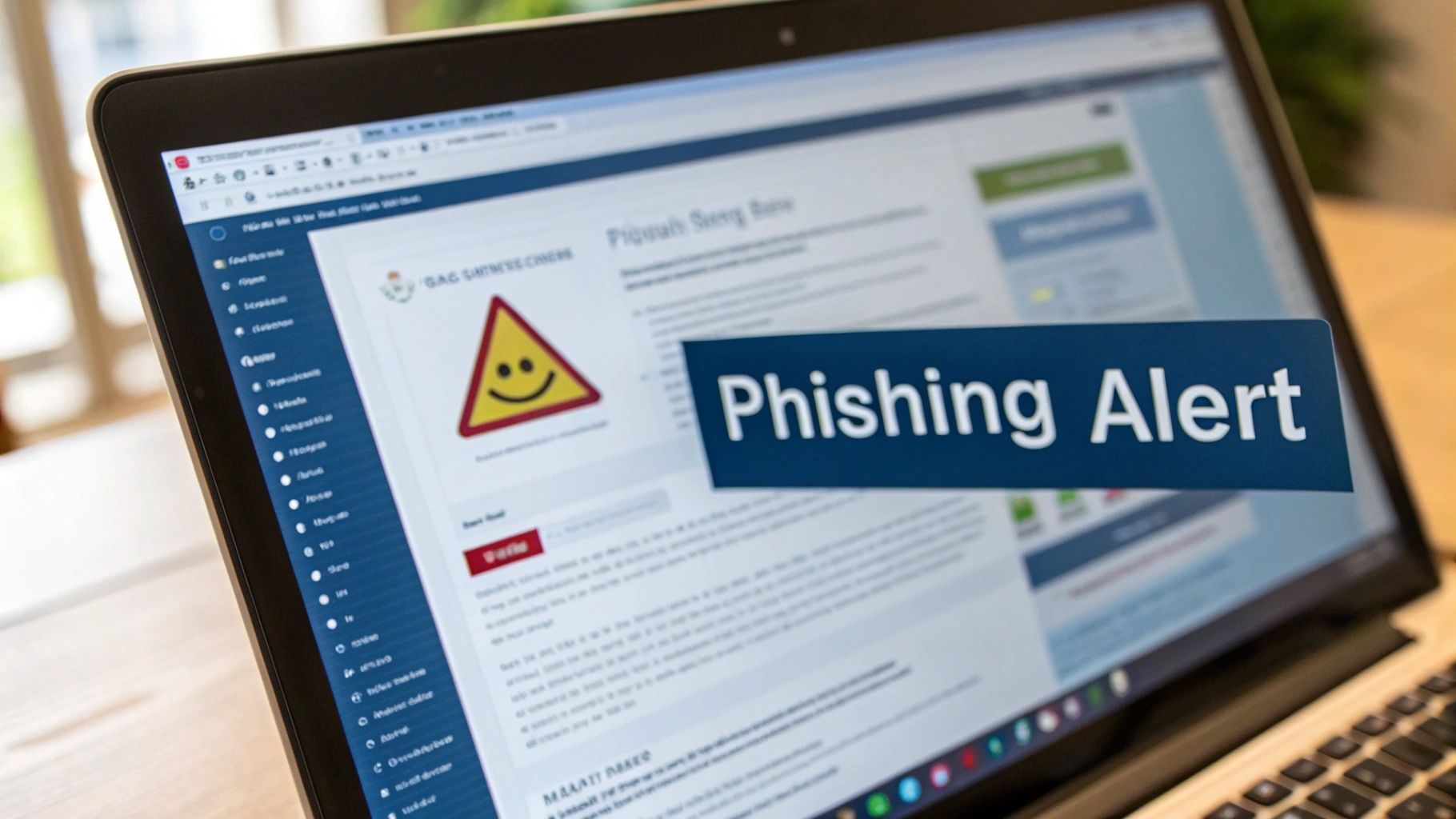Ultimate Guide to Phishing Attack Prevention: Strategic Solutions That Actually Work
Understanding Today's Phishing Landscape

Email scams have come a long way from obvious fraud attempts with broken English. Modern phishing attacks are increasingly difficult to spot, using advanced techniques that can fool even careful users. Understanding how these attacks work is essential for protecting yourself and your organization.
The Evolution of Phishing Tactics
Gone are the days of obvious scam emails from supposed Nigerian princes. Today's attackers use sophisticated social engineering combined with legitimate-looking business tools to bypass security. For example, they frequently exploit trusted platforms like Microsoft SharePoint and common file types like Visio (.vsdx) files to hide malicious links. Many attacks now start from hacked email accounts of real people, making them appear trustworthy. Scammers also carefully copy company branding and logos to create convincing fake pages. These targeted attacks, known as spear phishing, get much higher click rates than generic mass phishing attempts.
Why Traditional Defenses Fall Short
Standard security tools like spam filters and antivirus programs struggle to catch modern phishing attempts. These tools look for known patterns of malicious code, but today's attacks constantly change their methods and often use brand new exploits that security tools haven't seen before. Even when security software flags suspicious elements, clever social engineering tricks still convince many users to click anyway. The numbers tell the story – in 2023, 94% of organizations were successfully phished despite having basic protections in place.
Indicators of an Evolving Threat Landscape
Staying safe requires understanding the latest phishing trends. Key patterns include attackers using new file types like .vsdx documents, taking advantage of trusted business platforms, and creating highly personalized spear-phishing campaigns based on research about their targets. This means organizations need to move beyond just reacting to attacks and start anticipating new threats before they hit.
Building a Responsive Defense Strategy
Good phishing protection requires multiple layers – technology, training, and active monitoring. Understanding attacker tactics helps organizations teach employees what to watch for and put the right technical safeguards in place. Important steps include using advanced email security that can detect subtle signs of phishing, teaching security awareness through regular training, and running simulated phishing tests to identify weak spots. Since phishing tactics keep evolving, protection needs to be an ongoing process. The stakes are high – a single successful phishing attack can cost an organization millions in damages.
Transforming Employees Into Security Champions
Strong phishing defense starts with people, not just technology. Creating lasting security awareness means helping employees develop good habits and judgment through engaging training and reinforcement.
Cultivating a Security-First Mindset
Prevention comes down to getting employees to think carefully before acting. Instead of just reacting after something happens, staff need to learn to spot red flags proactively. A key shift is teaching people to pause and examine emails carefully – checking sender addresses, scrutinizing links, and questioning unusual requests. When this kind of careful analysis becomes second nature, organizations build real resilience against phishing.
Engaging Employees Through Interactive Training
Old-style lectures don't work well for security training. The best programs use hands-on exercises like mock phishing tests that let employees practice spotting threats safely. Walking through real examples of malicious links and attachments helps people understand exactly what to watch for. This practical experience sticks with them far better than just hearing about risks.
Leveraging Behavioral Psychology
To prevent phishing, we need to understand how people make decisions, especially under pressure. Training should address common psychological tricks that attackers use, like creating false urgency or offering tempting rewards. Teaching employees to recognize when someone is trying to manipulate their emotions helps them stay clear-headed when faced with suspicious messages.
Measuring and Maintaining Engagement
Regular testing helps track how well security training is working. For example, tracking click rates on simulated phishing emails shows which lessons are sticking and where more practice is needed. Keeping employees engaged requires steady reinforcement through reminders, updates about new threats, and fresh training content. Some organizations use points or rewards to encourage participation. The key is making security awareness part of everyday work culture, not just an annual training requirement. With consistent practice and reinforcement, employees become a strong first line of defense against increasingly clever phishing attempts.
Implementing Intelligent Email Defense Systems
While employee training is essential, technology also plays a key role in preventing phishing attacks. Organizations need to build strong defenses by combining multiple security tools and protocols. Basic spam filters alone aren't enough anymore – companies must adopt more sophisticated protection.
Advanced Threat Detection Technologies
Traditional email security that blocks known threats is no longer sufficient. Modern phishing attacks often use new exploits and social engineering tactics that slip past basic defenses. That's why tools like Dynamic URL Analysis and Machine Learning are crucial today. Dynamic URL Analysis checks linked websites in real-time to catch malicious redirects, even when they use legitimate services like Microsoft SharePoint. Machine Learning spots subtle patterns that could signal phishing, like unusual sender behavior or suspicious wording. This helps catch threats that basic filters might miss.
Strengthening Authentication and Access Control
Strong authentication is another vital part of phishing prevention. Multi-Factor Authentication (MFA) adds extra security by requiring users to verify their identity in multiple ways. Even if attackers steal passwords, they can't access accounts without the second verification step, like a code sent to the user's phone. The key is implementing MFA in a way that protects accounts without making it too cumbersome for legitimate users.
The Power of AI-Driven Solutions
AI has become essential for email security by analyzing vast amounts of data to spot new phishing tactics. AI systems can scan millions of messages quickly to identify suspicious patterns that human analysts might not catch. This helps organizations stay ahead of new threats. The systems can also customize alerts based on how each person typically uses email. For example, it can flag messages from unfamiliar senders pretending to be known contacts.
Integrating Human Expertise With Automated Systems
While technology is crucial, human expertise remains equally important. AI tools work best when combined with human analysis, not as a replacement. Security analysts provide critical context and judgment when investigating alerts from automated systems. For example, when the system flags a suspicious attachment, an analyst can determine if it contains legitimate business files or malicious code. Human oversight also helps prevent automated systems from being overly aggressive and blocking valid business emails.
Smart Protection Strategies for Limited Budgets
You don't need a big budget to defend against phishing attacks effectively. Small organizations can get strong protection by making smart choices about where to focus their limited resources. The key is identifying which basic security measures give you the most protection for your money.
Prioritizing High-Impact, Low-Cost Solutions
Employee training is one of the most powerful ways to prevent phishing attacks. Regular security awareness sessions and practice phishing tests can dramatically reduce the number of employees who click on malicious emails. You don't need expensive software – many good free training resources exist. For example, free phishing simulation tools let you test how well employees spot fake emails and identify weak spots in your defenses. This helps build up your "human firewall" by teaching employees to catch and report suspicious messages before any damage occurs.
Leveraging Free and Open-Source Tools
Many excellent security tools are available for free. Basic protections like password managers and two-factor authentication (2FA) add important security at no cost. You can also find free email filters and anti-phishing browser extensions to add more layers of defense. Using a mix of these free tools creates multiple barriers against phishing attempts.
Focusing on Prevention Over Remediation
While you need to be ready to handle incidents, preventing attacks saves more money in the long run. Teaching employees to spot phishing attempts and setting up basic security measures costs much less than dealing with a successful attack. Studies show phishing incidents often cost tens of thousands of dollars to fix, while prevention through training is relatively inexpensive. A small investment in prevention can avoid huge recovery costs later.
Building a Culture of Security Awareness
Beyond just tools and training, creating an environment where everyone thinks about security makes a big difference. Keep security tips flowing through regular team discussions and make sure people feel comfortable reporting anything suspicious. When employees can raise concerns without fear, your security team can address potential problems quickly before they grow. Share real examples of phishing attacks in team meetings to keep prevention fresh in everyone's minds. This ongoing focus helps make security part of your daily operations.
Building an Effective Incident Response Framework
Even with strong prevention measures in place, some phishing attacks may still succeed. That's why having a clear plan to respond to security incidents is essential. A well-designed incident response framework helps organizations act quickly when attacks occur, minimize damage, and strengthen their defenses by learning from each event.
Key Components of an Incident Response Plan
Here are the main elements that make up an effective incident response framework:
-
Preparation: Just like practicing fire drills, this stage involves assigning clear roles and responsibilities, establishing communication protocols, and regularly testing response procedures so everyone knows exactly what to do during an actual incident.
-
Identification: The faster a phishing attack is detected, the better. This requires monitoring user reports of suspicious emails and security system alerts to quickly confirm when an attack is happening.
-
Containment: Once an attack is confirmed, the priority becomes stopping it from spreading further. This may mean isolating affected systems, blocking malicious URLs, or disabling compromised accounts before more damage occurs.
-
Eradication: This phase focuses on fully removing the threat by cleaning infected systems, patching security gaps, and resetting any compromised passwords to prevent the same attack from happening again.
-
Recovery: Getting systems back to normal requires having reliable backups and a clear process to restore data and operations with minimal disruption.
-
Post-Incident Activity: After each incident, the team analyzes what happened, what worked well in the response, and what needs improvement. These lessons directly inform and strengthen future security measures.
Communication During an Incident
Clear communication is critical throughout the incident response process. Keeping employees, management and potentially affected customers or partners informed helps maintain trust and prevent confusion. Having pre-defined communication channels and message templates makes this much smoother. Quick, transparent updates can significantly reduce both operational disruption and reputational damage.
Turning Incidents Into Learning Opportunities
Every phishing incident provides valuable insights to improve security, no matter how small. By analyzing how attacks succeed, where defenses fall short, and how well the response worked, organizations can continuously strengthen their protection. For example, if a particular type of phishing email gets through existing filters, those filters can be updated based on the analysis. According to Trend Micro, 94% of organizations faced phishing attacks in 2023, showing why this cycle of learning and improvement is so important. With a solid incident response framework and commitment to learning from each event, organizations can better protect themselves as phishing tactics continue to evolve.
Measuring Success and Evolving Your Phishing Attack Prevention Strategy
Good security requires ongoing monitoring and improvement – especially when it comes to protecting against phishing attacks. After putting your initial defenses in place, you need a systematic way to measure their performance and make adjustments based on real data. This matters because phishing methods change frequently, requiring you to stay responsive and update your approach.
Establishing Meaningful Benchmarks
The first step in measuring success is setting clear reference points. You need to know your starting position for key metrics – for example, what percentage of employees click simulated phishing emails during testing? How long does it typically take your team to investigate and address reported phishing attempts? Getting this baseline data gives you a factual view of your current security and a foundation for tracking improvement over time.
To set these benchmarks, you may need to look through existing security logs, run internal assessments, or use dedicated phishing simulation software. These tools help reveal how susceptible your employees are to different types of phishing attempts. With clear starting points established, you can begin measuring the real impact of your prevention efforts.
Tracking Key Performance Indicators (KPIs)
Once you have your benchmarks, focus on tracking specific KPIs that show whether your strategy is working:
- Phishing Simulation Click Rates: When fewer employees click test phishing emails, it shows better awareness and judgment. For example, dropping from a 15% to 5% click rate indicates strong improvement.
- Incident Response Time: Quick detection and handling of phishing attempts limits potential damage. Monitoring response times helps identify and fix bottlenecks in your process.
- Number of Reported Phishing Emails: More employees reporting suspicious emails, even if some are false alarms, shows they're engaged in prevention and comfortable speaking up about concerns.
- Financial Impact of Incidents: Adding up costs from downtime, lost work time, and recovery helps show leadership the value of investing in security.
Regular review of these metrics reveals what's working well and what needs attention. The numbers themselves matter less than understanding what they tell you about your overall security position.
Adapting Your Strategy Based on Data
Let your KPI data guide how you adjust and improve your prevention approach. If simulated phishing tests show high click rates for certain types of fake emails, you may need to update training to better cover those specific tactics. Or if incident response takes too long due to unclear communication, that points to improving your response procedures and communication tools.
Stay informed about new phishing techniques appearing in your industry so you can prepare proactively. This could mean updating email filters, adding stronger authentication, or exploring new security tools. Just as attackers keep changing their methods, your defenses need to keep developing to provide reliable protection.
Want a more robust way to prevent data breaches and enhance your cybersecurity measures? DebugBar offers comprehensive resources and insights on the latest digital security trends, helping you stay ahead of evolving threats. Learn more at https://www.debugbar.com.


